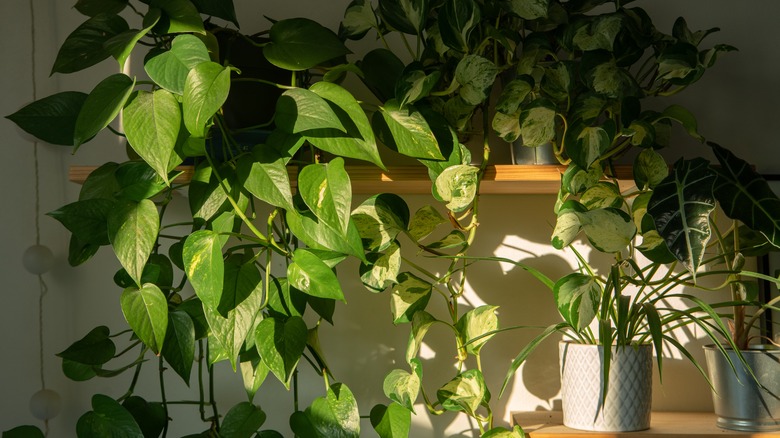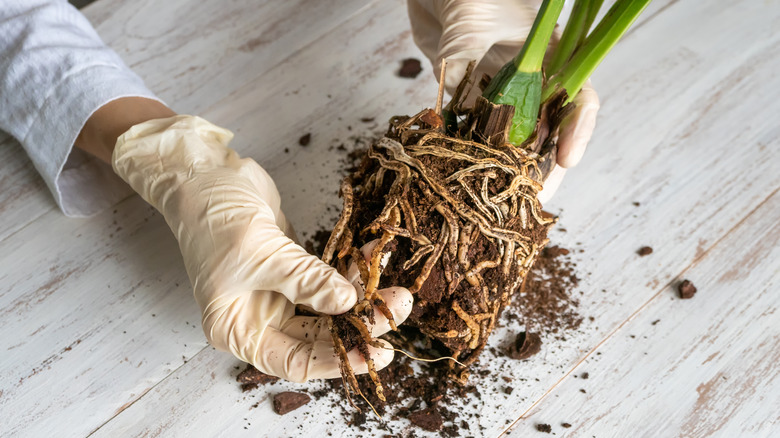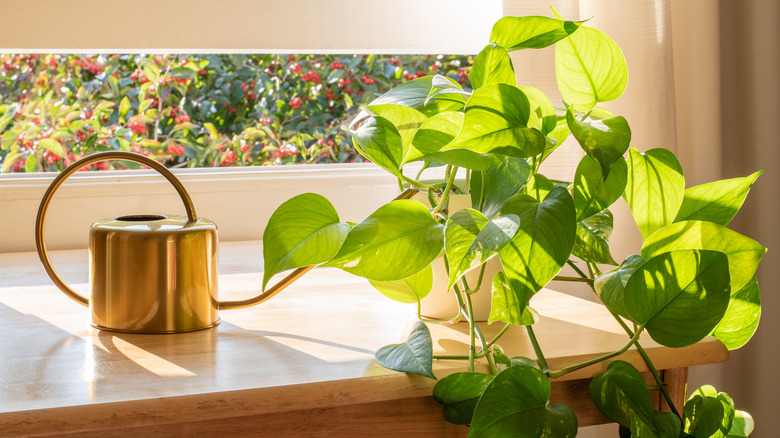What's The Best Way To Treat Root Rot On Pothos Plants?
Pothos plants (Epipremnum Aureum) are one of the most common household plants due to their low maintenance qualities, such as needing indirect light and being more forgiving with infrequent watering and neglect. This climbing vine is also incredibly fun to style — whether you let it grow up your wall or towards the floor in a hanging basket, its bright foliage always livens up the room.
Britannica's synopsis of the pothos is that it is an evergreen plant with heart-shaped foliage with yellow markings. These characteristics give the pothos other nicknames like golden pothos, money plant, and the devil's Ivy. Other well-known variations of pothos include the marble queen with white variegation and the tricolor with white and yellow variegation. While the native southeastern Asian plant is one of the most highly recommended for new plant beginners, its relaxed care is not foolproof. Like every other plant, the pothos is susceptible to root rot if not properly tended to.
How to identify root rot
When owning houseplants, it is essential to understand the signs and causes of root rot. House Plant Authority identifies the top signs of root rot to be wilting leaves, falling leaves, stunted growth, leggy growth, brown leaf splotches, and of course, mushy and discolored roots. But early signs of this disease are the wilting and dropping of leaves and stunted and leggy growth. An excellent way to determine if root rot may be the culprit for this is to stick a finger far into the soil. If the soil is relatively dry, your plant is most likely thirsty. However, your pothos plant likely has root rot if it is very moist.
When a plant develops root rot, the affected roots no longer produce chlorophyll, which is needed for photosynthesis (via House Plant Authority). Plantophiles outline that the most common reason for root rot is overwatering, but another possibility is that the plant has a fungal infection, also called a soil-borne disease. Yellowing leaves will typically be attributed to overwatering, while brown and black leaves are more likely to be caused by a fungal infection. The longer your pothos sits in overly wet and humid conditions, the quicker root rot will set in and feast on your beloved plant.
How to treat root rot
Although root rot looks grim for your pothos plant's future, it can be saved. Gardenine's guide to healing your sick plant starts with removing it from its pot and cleaning its roots with water. This will give a soil-free and clear view of the roots, allowing for easy identification of the harmed roots versus the healthy ones. Healthy roots will be firm and white or light in color, and rotted roots will be pretty dark with a very mushy feel and sometimes an odor. After you figure out everything, the next step is to take clean scissors or shears and cut off the rotted roots.
Once all of the dead roots have been removed, it is advised by Plantophoiles to spray the remaining healthy roots with a 3% hydrogen peroxide solution or 70% isopropyl. Spraying your pothos' remaining roots with these solutions boots soil oxygen levels and will kill any possible fungal bacteria that may have been resting on them. Your pothos can start its recovery after repotting it in a completely new and fresh potting mix.
How to avoid root rot
Luckily, the pothos plant has a reasonable recovery rate for root rot, but it is best to avoid it altogether by taking some easy precautions. According to Hey Rooted, root rot can be prevented by always providing adequate draining, including dumping the draining tray and adding things like charcoal mixes and rocks to aid soil aeration abilities.
It is also safer to air on the side of caution and always underwater rather than overwater. It is much easier for a plant to overcome issues that arise from underwatering rather than overwatering. A good rule of thumb is to allow your soil to dry between waterings. Another thing to keep in mind is that you should always keep any plants with root rot away from your healthy ones. If you follow these steps, your pothos should recover in no time, or better yet, not experience root rot at all.



